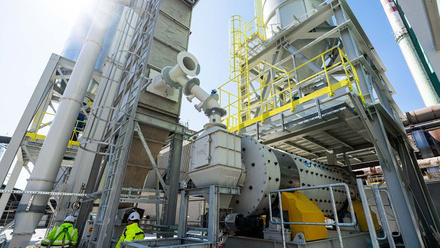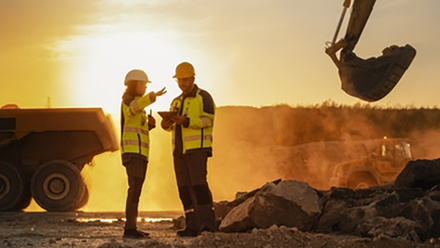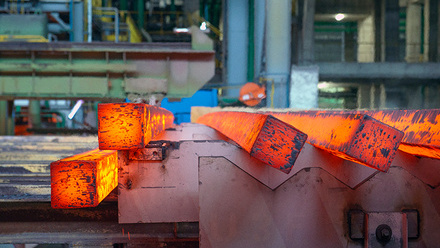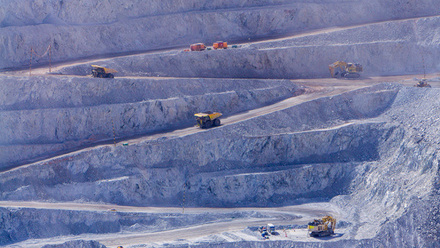Lost in the sand?
Shortages in sand supply and environmental impacts.

Sand – like water – is at long last being acknowledged as crucial to the survival and advancement of the human race. On one hand supply is proving a problem in some regions. On the other hand, unlimited extraction of sand is leading towards erosion, flooding, aquifer salination and coastal defence destruction.
Among those campaigning to prevent this destruction is the UN Environment Programme (UNEP).
Pascal Peduzzi, Director of UNEP/GRID-Geneva (GRID is the Global Resource Information Database network), was asked whether UNEP perceives a shortage of sand reserves. 'Yes, yet not globally. There are specific locations where accessing sand resources is becoming difficult, either because the resource is scarce or because physical access is making extraction complex.
'Recently, work to increase the size of Manila International Airport in the Philippines had to be postponed for one year given the lack of sand for the construction work.'
Peduzzi continues, 'Singapore is importing sand from neighbouring countries, while Belgium and the Netherlands have made their assessment – marine sand resources will be exhausted in Belgium’s national waters within 80 years and by the second half of this century for the Netherlands. Small islands are also facing sand shortages.'
Mark Russell, Executive Director of the UK Mineral Products Association, notes the problem in the UK is less of limited reserves but permission to extract them.
'In Britain, we are fortunate to have a wide variety of geological resources that allow us to be almost entirely self-sufficient in crushed rock, gravel and sand. The challenge is to ensure that sufficient resources are permitted through the planning system to allow a steady and adequate supply of essential minerals in accordance with national policy.
'The nation is currently consuming resources faster than they are being replaced, because for every 100t of sand and gravel consumed over the last decade, only 63t have been replaced, while for crushed rock, the replacement figure is even lower.
'The issue is less about the physical availability of mineral resources, albeit they are distributed unevenly across the country, it is more about access to suitable resources being permitted through the planning and environmental regulatory regimes.'
Supplying the American input is Professor James Best, of the Department of Earth Science & Environmental Change at the University of Illinois Urbana Champaign. He is co-author of a 2019 article in nature on Time is running out for sand.
He says, 'In some regions of the world, [it] is undoubtedly the case [that] riverine sand reserves have been exhausted…and thus this question needs to be addressed in its local, regional and global context.
'Globally, some estimates of demand versus supply suggest we are reaching the point where supply is beginning to lag demand, although this is largely lacking consideration of recent progress in reuse of sand and alternatives to sand.
'In addition, all sand is not equal and sand for differing purposes has differing characteristics.' (See A supply paradox).
Extracting effects
Turning to the environmental effects of over-extraction, Russell says, 'This isn’t so much an issue in Britain, as extraction activity is managed through a rigorous planning and environmental regulatory regime to ensure that extraction only takes place in appropriate locations, with conditions in place to manage and mitigate potential impacts.
'In many respects, the environmental effects of extraction can be viewed as positive in the long term, given the restoration of sites back to nature once operations have concluded. The sector has created more than 80km2 of priority habitat through quarry restoration to date, with a further 110km2 planned'.
Peduzzi also notes that environmental impact depends on where the sand is being extracted. 'We differentiate between static and dynamic settings. In static settings (quarries which crush rocks), the sand doesn’t interact with the ecosystems and the impacts are mostly visual (landscape). In dynamic settings (rivers, beaches and/or marine environments), the impacts are important as sand is directly interacting with the environment.'
Peduzzi differentiates between:
- Rivers – by deepening the riverbed, sand extractions change the water flow, which can lead to flooding or lowering the water-table level. It can also lead to riverbank erosion. The change in turbidity (suspended particles into the water) can impact biodiversity and fish population.
- Beaches – sand is the first line of defence against intensifying storm surges and sea level rise. Sand extraction can lead to more coastal erosion and salination of coastal aquifers. Beach sand is also a habitat for fauna (birds, turtles, crabs and fishes), which will be impacted. What is more, sand mining from the beach prevents future touristic uses.
- The marine environment – where extraction of sand at the bottom of the sea has impacts on biodiversity, fisheries and water turbidity. If this is carried out too close to the shore, it can also lead to coastal erosion.
Noting these effects, Best adds, 'It is also vital to appreciate there are changes to the human landscape as well as the physical landscape, in that sand mining – especially where illegal – has been linked to social inequality, crime, destruction of longer-term livelihoods, domestic violence and gender inequalities, to name but a few.
'In some countries, the fightback is occurring. For example, in some sites we have been monitoring in Bangladesh, bans on gravel mining were brought in four/five years ago and are having a dramatic effect on both the ‘recovery’ of the river channels and their ecology, but also on the local population, both advantageous (e.g. restoring fish stocks, reducing pollution and decreasing crime associated with mining), but also disadvantageous (e.g. loss of income and livelihoods linked to mining).
'Sand mining can both contribute to – and act against – achieving some of the UN Sustainable Development Goals.'
In the mix
Best also points out the difference in quality in sand that is marine-won and land-won. Generally riverine sand is more angular than desert sand. It is also non-saline compared to marine sand.
'As such, it makes for better sand to produce a stronger concrete. The mineral make-up of the sand is also important and will depend on the geology of the area from which the sand is derived – this may show considerable local variation.
'Sands rich in quartz are better sought after compared with, for example, sands richer in feldspar minerals that have a greater range of different elements in them. In addition, in modern environments, the grain size mix of sands varies. Generally, it is desirable not to have too high a percentage of very fine sediment, less than around 0.1mm in diameter. The presence of any clays within a sand is also largely detrimental for the manufacture of concrete.'
Peduzzi adds, 'Marine-sand and land-sand can be similar or varied, depending on whether the marine-sand comes from inland via rivers or if it is created by wave erosion. In all cases, marine sand includes salt from the sea and this means that it should be washed with freshwater prior to being used for making concrete.'
Best summarises, 'Thus, the quality of sand is site and environment specific, and determines its usage to a great degree.'
In the UK, 'The origin of land-won sand and gravel deposits in Britain is almost identical to those resources that are extracted offshore i.e. fluvio-glacial deposits created and laid down during the various periods of global cooling (Ice Ages),' explains Russell. 'The relict (fossil) deposits are associated with ancient river courses, and the main difference is that the marine deposits have become submerged by sea-level rise.'
He shares, 'In terms of their geological composition, quality and what they can be used for, they are largely interchangeable, with product standards not differentiating between land-won or marine-won aggregates. Consequently, marine aggregate supplies contribute ~25% of all the sand and gravel used in England and ~50% of the material used in Wales.
'In London and the Southeast of England, where one-third of all construction activity in Great Britain takes place, marine aggregate supplies contribute one-third of the demand for primary aggregates.'
Circles in the sand
Can the circular economy help recycle sand and secure sustainable supply? Russell answers, 'Of course, but there are inevitable limits. In Britain, around 30% of construction aggregate needs are already derived from recycled or secondary sources, so, in this respect, the circular economy is already having an influence in reducing the amount of material that would perhaps otherwise be disposed of as waste and in turn reducing the demand on primary aggregate supplies.
'But there are challenges – the availability and supply can be inconsistent, both geographically and temporally, given the need for suitable feedstock to generate these alternative resources, whether this is hard construction and demolition waste from urban redevelopment, or alternative materials derived as a byproduct of other industrial processes.'
Peduzzi is also cautiously positive on this issue. 'Sure, this is one of the possibilities. Yet, when sand is mixed with gravels and cement to make concrete, it is not sand anymore. So, we can recycle concrete to make new concrete, understanding that fresh sand will still be needed. However, recycling concrete can greatly help to reduce the demand for new material. We can also retrieve it from waste (bottom ashes), as long as the heavy metals are retrieved when cleaning these ashes.'
Most forceful are Best’s views. 'Reuse and new design, and alternatives to sand, are critical to achieving a more sustainable future for sand.'
But there is a cost penalty 'in the cost of the collection and processing to prepare materials to be reused', notes Best. 'This also involves factors such as the distance to the intended market. These economic factors determine the cost-effectiveness of reuse, which is likely to become more critical in developing economies.'
Peduzzi offers an example of where legislation can help incentivise the circular economy, 'In the UK, since 1994, dumping demolition wastes is taxed, meaning that recycling this material will avoid payment of the tax for the amount recycled. In the medium-to-long term, the costs of not reaching a circular economy will be very high.'
Russell concurs. 'Landfill tax provides a financial incentive to retain as much waste in the economy as possible, and for recycled and secondary aggregates, these are also exempt from the Aggregates Levy – a tax that applies to the consumption of primary aggregate materials. Both provide commercial drivers to maximise the reuse of materials.
'However, there is an energy cost associated with processing materials and then transporting them to where they may be needed – which is why most reuse occurs in urban areas. It is also important to ensure recycled materials are used in the right way. While there can be an ambition to push them up the value chain, this can result in unintended outcomes.
'Use of recycled aggregates in concrete can result in higher quantities of cement and water to be used, while diverting recycled aggregates from bulk-fill end-uses can result in that use being replaced by alternative sources of material – often from primary sources.'
Russell emphasised the need for strategic planning. 'The rate at which aggregate reserves are being replaced falls some way behind the rate at which the resources are being used and has done for some time now. The availability of these materials requires strategic, long-term planning to ensure the right materials are available in the right place and at the right time. Rather than assuming the availability and supply of these strategic development resources, their availability needs to planned for, monitored and managed.
'That being said, even for a sand and gravel site, it will still take perhaps 10 years to secure the necessary planning and regulatory permissions. Hence the need for strategic planning.'
Taking stock

In a 2019 article, Time is running out for sand, published in nature, four authors, including Professor James Best, interviewed here, summarised seven factors vital for sustainable sand extraction.
- Sustainable sand sources must be identified and certified as such.
- Governmental and planning authorities must encourage alternatives, e.g, crushed rock, industrial slag, copper, fly ash and recycled plastic.
- Sand must be reused – demolition waste and concrete can be crushed and mixed into cement, and rubble can be used as a base aggregate in foundations and roads.
- Reducing concrete quantities with consequent lower sand use.
- Frameworks to govern sand extraction at every possible level.
- Education regarding sand issues, including solutions.
- Global monitoring, including remote sensing.
Environment, sand and governance
Peduzzi comments on measures that are being, or should be taken, to reverse the consequences of over-extraction. 'It greatly depends from one country to the next, and yet for all countries the answer will be ‘not enough measures’.'
There are several possibilities:
- Reducing demand for sand by using resources in a wiser way and avoiding wastage
- Selecting the right type of sand for the right application
- Recycling concrete
- Retrieving from waste, which requires high tech
- Co-generation of ore-sand and ore in mining
- Replacing it with other building materials (e.g. straw, adobe, bricks, wood or bamboo)
- Regenerating sites after extraction
One potential alternative is ore-sand. Russell is cautious about its use. 'The recycled/secondary aggregate consumption shows there is the potential for significant substitution if the right alternative resources are available. But it will be limited by the availability and cost-effectiveness of the alternative sources of supply'.
For Best, 'In some circumstances yes, but in the vast majority of uses – for landfill, concrete and construction – this would be impractical and too costly.'
Peduzzi weighs in, 'Ore-sand is sand and not an alternative to sand. Ore-sand is cogenerated along with extraction of other ore, e.g. iron or copper. Until recently, mining companies were extracting the ore and leaving other material in tailings – thus generating 30-60Bt/y of tailings. If mining companies were to shift (wherever possible, meaning chemical and physical testing of their material) to co-generation of ore and ore-sand, this is perhaps the largest solution in terms of volume.'
The experts confirm the sheer complexity of quantifying and monitoring excessive sand exploitation and that is before formulating strategies for reversing the squandering of a vital resource.







